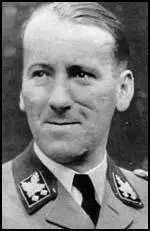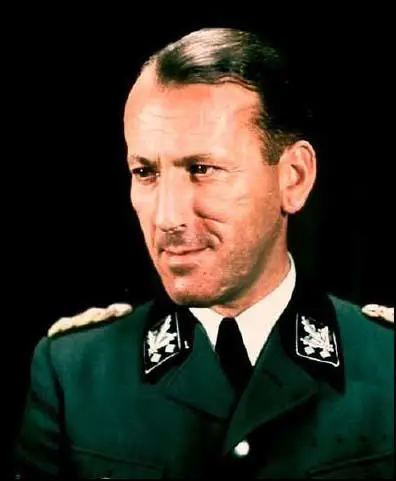Ernst Kalenbrunner

Ernst Kaltenbrunner, the son of a lawyer, was born in Austria on 4th October, 1903. He got a doctorate in law from Graz University in 1925 and set up as a lawyer in Linz.
Kaltenbrunner joined the Austrian Nazi Party in 1932 and worked closely with Arthur Seyss-Inquart and Adolf Eichmann. Kaltenbrunner became head of the Austrian SS in 1934 but soon afterwards was arrested and accused of being involved in the assassination of Engelbert Dollfuss. Found guilty of conspiracy and was sentenced to six months in prison.
After Anschluss Kaltenbrunner was elected to the Reichstag and became minister for state security as well as police chief in Vienna. During the next three years Kaltenbrunner served as Commander-in-Chief of the Schutzstaffel (SS) in Vienna.
In April 1941 Kaltenbrunner was appointed Lieutenant-General of Police. He impressed Heinrich Himmler and when Reinhard Heydrich was assassinated in May, 1942, Kaltenbrunner was appointed as head of the SD (Sicherheitsdienst). In this position he not only controlled the Gestapo but also the concentration camp system and was responsible for carrying out the Final Solution.
Nearly seven feet tall, with deep scars on his face from his student duelling days, Kaltenbrunner appeared to obtain pleasure from his work and took personal interest in the different methods of killing the inmates in the extermination camps. As well as the hunting down and extermination of several million Jews Kaltenbrunner was also responsible for the murder of Allied parachutists and prisoners-of-war.

With the Red Army closing in on Germany, Kaltenbrunner gave orders for all prisoners in extermination camps to be killed and then fled south but was captured by Allied troops. In May 1945, Winston Churchill, Harry S. Truman, Joseph Stalin and Charles De Gaulle agreed that an international military tribunal should try the leaders of Nazi Germany for war crimes. It was decided to charge the men and women on four counts: crimes against peace (planning and making war); war crimes (responsibility for crimes during war); crimes against humanity (racial persecution) and conspiracy to commit other crimes.
At the Nuremberg War Crimes Trial Kaltenbrunner said he did not know of the final solution before 1943. "Immediately after receiving knowledge of this fact I fought, just as I had done previously, not only against the final solution, but also against this type of treatment of the Jewish problem.... I protested to Hitler and the next day to Himmler. I did not only draw their attention to my personal attitude and my completely different conception which I had brought over from Austria and to my humanitarian qualms, but immediately from the first day, I concluded practically every one of my situation reports right to the very end by saying that there was no hostile power that would negotiate with a Reich which had burdened itself with this guilt." Chiefly thanks to his intervention, Kaitenbrunner ventured, the persecution of Jews ended in October 1944.
Ernst Kaltenbrunner, Wilhelm Frick, Hans Frank, Walther Funk, Fritz Saukel, Alfred Rosenberg, Julius Streicher, Alfred Jodl, Wilhelm Keitel, Arthur Seyss-Inquart, Karl Brandt, Viktor Brack and Joachim von Ribbentrop were all found guilty and executed on 16th October, 1946.
Primary Sources
(1) Statement made by Ernst Kaltenbrunner on the scaffold on 1st October 1946.
I have loved my German people and my fatherland with a warm heart. I have done my duty by the laws of my people and I am sorry my people were led this time by men who were not soldiers and that crimes were committed of which I had no knowledge.
(2) The journalist, Howard K. Smith, observed the execution of Ernst Kaltenbrunner and nine other leaders of the Nazi Party on 1st October 1946.
Ernst Kaltenbrunner entered the execution chamber at 1.36 a.m., wearing a sweater beneath his blue double-breasted coat. With his lean haggard face furrowed by old duelling scars, this terrible successor to Reinhard Heydrich had a frightening look as he glanced around the room.
He wet his lips apparently in nervousness as he turned to mount the gallows, but he walked steadily. This was the man, one of whose agents - a man named Rudolf Hoess - confessed at a trial that under Kaltenbrunner's orders he gassed 3 million human beings at the Auschwitz concentration camp!
As the black hood was raised over his head Kaltenbrunner, still speaking in a low voice, used a German phrase which translated means, "Germany, good luck."
